Kia Stonic vs Mazda CX-30 – Differences & prices compared
Compare performance, boot capacity, efficiency and price at a glance.
Find out which car is the better choice for you – Kia Stonic or Mazda CX-30?
Costs and Efficiency:
Looking at overall running costs, both models reveal some interesting differences in everyday economy.
Kia Stonic has a clearly perceptible advantage in terms of price – it starts at 20100 £, while the Mazda CX-30 costs 25200 £. That’s a price difference of around 5100 £.
Fuel consumption also shows a difference: Kia Stonic manages with 5.60 L and is therefore barely noticeable more efficient than the Mazda CX-30 with 5.70 L. The difference is about 0.10 L per 100 km.
Engine and Performance:
Power, torque and acceleration are the classic benchmarks for car enthusiasts – and here, some clear differences start to show.
When it comes to engine power, the Mazda CX-30 has a distinct edge – offering 186 HP compared to 115 HP. That’s roughly 71 HP more horsepower.
In acceleration from 0 to 100 km/h, the Mazda CX-30 is evident quicker – completing the sprint in 8.30 s, while the Kia Stonic takes 10.70 s. That’s about 2.40 s faster.
In terms of top speed, the Mazda CX-30 performs somewhat better – reaching 204 km/h, while the Kia Stonic tops out at 182 km/h. The difference is around 22 km/h.
There’s also a difference in torque: Mazda CX-30 pulls to a small extent stronger with 240 Nm compared to 200 Nm. That’s about 40 Nm difference.
Space and Everyday Use:
Whether family car or daily driver – which one offers more room, flexibility and comfort?
Both vehicles offer seating for 5 people.
In curb weight, Kia Stonic is clearly perceptible lighter – 1205 kg compared to 1455 kg. The difference is around 250 kg.
In terms of boot space, the Mazda CX-30 offers a bit more room – 430 L compared to 352 L. That’s a difference of about 78 L.
In maximum load capacity, the Mazda CX-30 performs a bit better – up to 1406 L, which is about 251 L more than the Kia Stonic.
When it comes to payload, Mazda CX-30 somewhat takes the win – 496 kg compared to 445 kg. That’s a difference of about 51 kg.
Who wins the race?
The Mazda CX-30 proves to be is largely superior and therefore becomes our DriveDuel Champion!
Mazda CX-30 is the better all-rounder in this comparison.
 @ Mazda Motor Corporation
@ Mazda Motor Corporation
Mazda CX-30
Kia Stonic
The Kia Stonic is a sprightly compact crossover that mixes city-friendly agility with a cheeky, modern design — perfect for buyers who want style without sacrificing sense. Inside it serves up clever practicality and a bright, well-equipped cabin, making everyday driving feel a bit more fun than it has any right to be.
details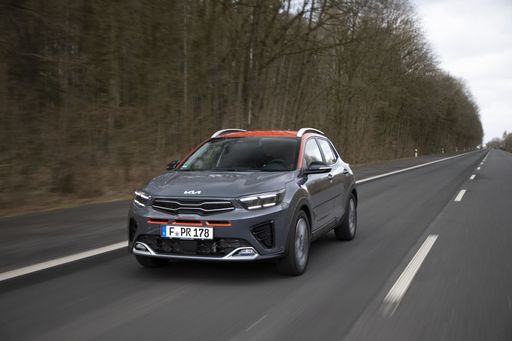 @ Kia Corporation
@ Kia Corporation
 @ Kia Corporation
@ Kia Corporation
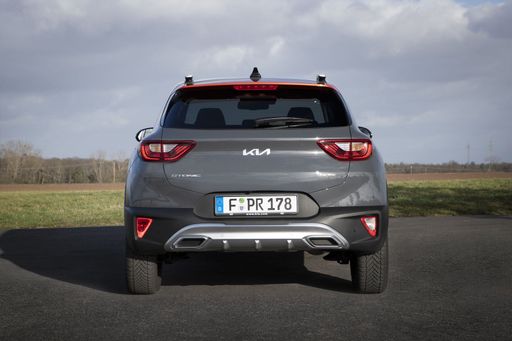 @ Kia Corporation
@ Kia Corporation
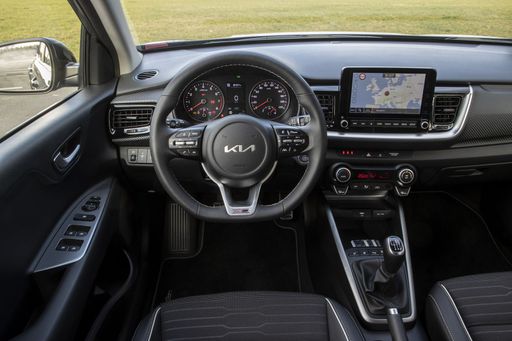 @ Kia Corporation
@ Kia Corporation
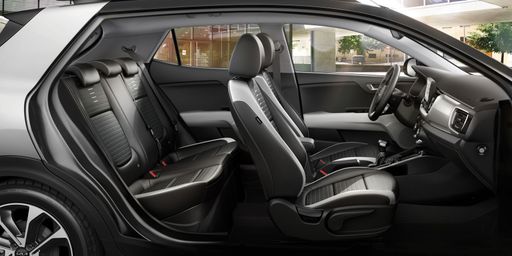 @ Kia Corporation
@ Kia Corporation
Mazda CX-30
The Mazda CX-30 blends sleek coupe-like lines with the practicality of a compact crossover, feeling more premium than its price tag suggests. It’s a joy to drive for anyone who likes a taut chassis and an interior that treats daily commutes like a small luxury escape.
details @ Mazda Motor Corporation
@ Mazda Motor Corporation
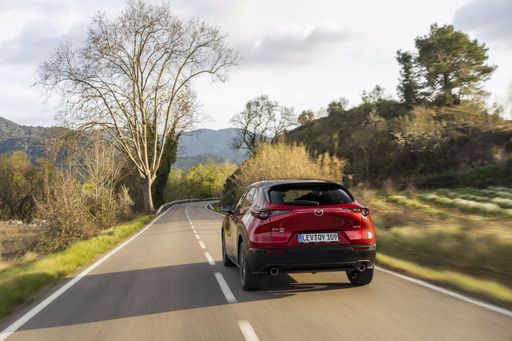 @ Mazda Motor Corporation
@ Mazda Motor Corporation
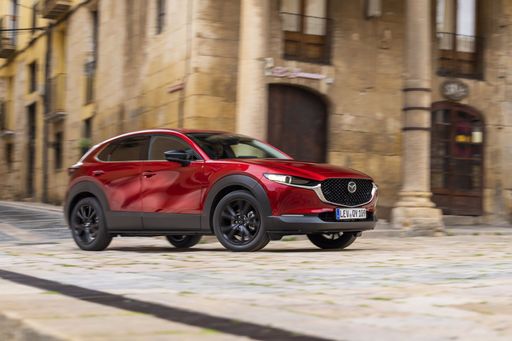 @ Mazda Motor Corporation
@ Mazda Motor Corporation
 @ Mazda Motor Corporation
@ Mazda Motor Corporation
 @ Kia Corporation
@ Kia Corporation
|
 @ Mazda Motor Corporation
@ Mazda Motor Corporation
|
|
|
|
Costs and Consumption |
|
|---|---|
|
Price
20100 - 26600 £
|
Price
25200 - 36800 £
|
|
Consumption L/100km
5.6 - 5.9 L
|
Consumption L/100km
5.7 - 6.6 L
|
|
Consumption kWh/100km
-
|
Consumption kWh/100km
-
|
|
Electric Range
-
|
Electric Range
-
|
|
Battery Capacity
-
|
Battery Capacity
-
|
|
co2
127 - 133 g/km
|
co2
129 - 148 g/km
|
|
Fuel tank capacity
45 L
|
Fuel tank capacity
48 - 51 L
|
Dimensions and Body |
|
|---|---|
|
Body Type
SUV
|
Body Type
SUV
|
|
Seats
5
|
Seats
5
|
|
Doors
5
|
Doors
5
|
|
Curb weight
1205 - 1270 kg
|
Curb weight
1455 - 1587 kg
|
|
Trunk capacity
352 L
|
Trunk capacity
422 - 430 L
|
|
Length
4165 mm
|
Length
4395 mm
|
|
Width
1760 mm
|
Width
1795 mm
|
|
Height
1520 mm
|
Height
1540 mm
|
|
Max trunk capacity
1155 L
|
Max trunk capacity
1398 - 1406 L
|
|
Payload
440 - 445 kg
|
Payload
458 - 496 kg
|
Engine and Performance |
|
|---|---|
|
Engine Type
Petrol, Petrol MHEV
|
Engine Type
Petrol MHEV
|
|
Transmission
Manuel, Automatic
|
Transmission
Manuel, Automatic
|
|
Transmission Detail
Manual Gearbox, Dual-Clutch Automatic
|
Transmission Detail
Manual Gearbox, Automatic Gearbox
|
|
Drive Type
Front-Wheel Drive
|
Drive Type
Front-Wheel Drive, All-Wheel Drive
|
|
Power HP
100 - 115 HP
|
Power HP
140 - 186 HP
|
|
Acceleration 0-100km/h
10.7 - 12.1 s
|
Acceleration 0-100km/h
8.3 - 10.3 s
|
|
Max Speed
179 - 182 km/h
|
Max Speed
191 - 204 km/h
|
|
Torque
172 - 200 Nm
|
Torque
238 - 240 Nm
|
|
Number of Cylinders
3
|
Number of Cylinders
4
|
|
Power kW
74 - 85 kW
|
Power kW
103 - 137 kW
|
|
Engine capacity
998 cm3
|
Engine capacity
1998 - 2488 cm3
|
General |
|
|---|---|
|
Model Year
2025
|
Model Year
2025
|
|
CO2 Efficiency Class
D
|
CO2 Efficiency Class
D, E
|
|
Brand
Kia
|
Brand
Mazda
|
Is the Kia Stonic offered with different drivetrains?
The Kia Stonic is offered with Front-Wheel Drive.
The prices and data displayed are estimates based on German list prices and may vary by country. This information is not legally binding.
